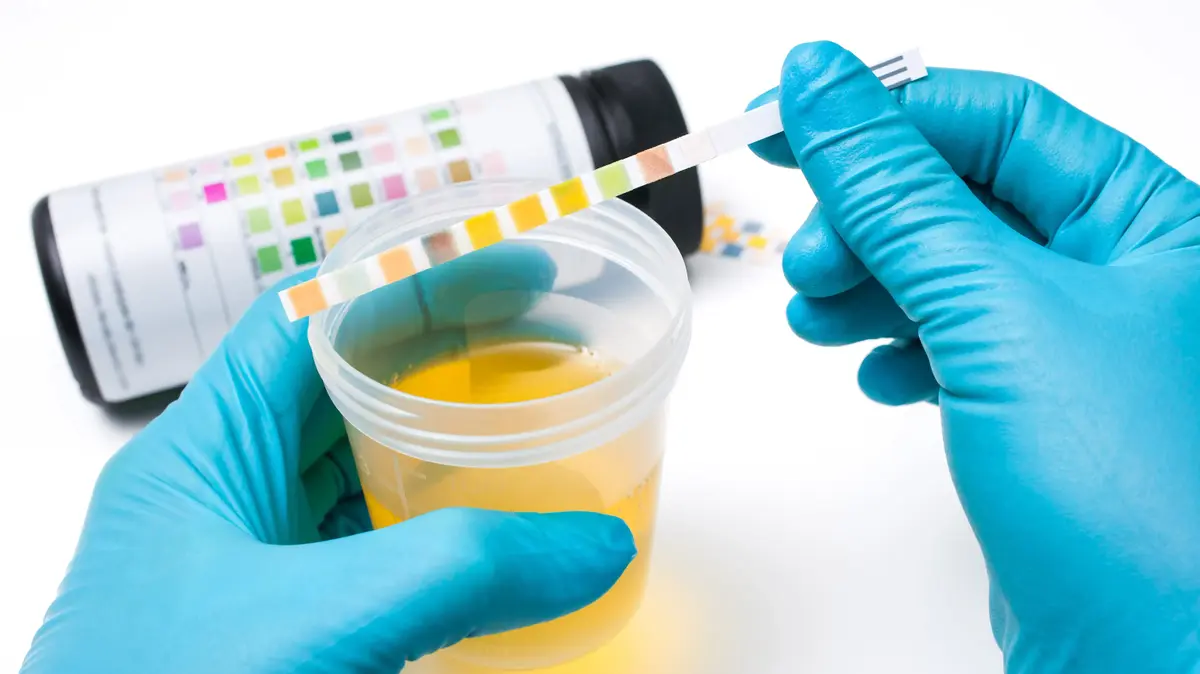What you need to know about the covid-19 breath test 2:15
(CNN) --
As Covid-19 cases rise in the United States, experts are questioning whether the nation has a realistic understanding of the current threat posed by the pandemic.
The Institute for Health Metrics and Evaluation (IHME) estimates that only 7% of positive cases of covid-19 in the United States are being detected, which means that the case rates are actually 14.5 times higher than those officially reported.
The last time the infection detection rate was this low was early in the pandemic, in March 2020.
"It's a dynamic situation, and things are changing rapidly," said Ali Mokdad, a professor and chief population health strategist at IHME.
Cases have long been underestimated, but one of the reasons they may be so far off the mark is that the number of COVID-19 tests being done in non-traditional settings, like at home, has already exceeded the number being tested. performed in laboratories, according to the National Institutes of Health (NIH).
As the use of home tests for COVID-19 increases, so are concerns that most test results are not being reported, leading to an undercount of the actual number of COVID-19 cases in the country. the whole country.
Another reason detection is so low, according to Mokdad, is that most people infected with the omicron variant of the coronavirus show no symptoms, so they don't even know they need to get tested.
advertising
Errors when doing the covid-19 home test that you should avoid
Why is testing important?
According to Mokdad, many diseases have a low detection rate, such as the flu.
"The difference is that this is a pandemic," he said.
When people learn that there are many cases of covid-19 in their area, some may be more cautious.
That can prevent them from getting sick and spreading the virus.
The tests can also tell public health experts what steps need to be taken to keep people safe.
For example, when Philadelphia recently saw a spike in cases, it reinstated the use of masks indoors.
"We have to always stay ahead of this and not just hope it goes away," said Mara Aspinall, a testing expert and professor of practice at the Arizona State University College of Health Solutions.
Testing is also important on an individual level.
They tell people if they should isolate themselves so as not to infect other people.
It also tells them if they need to seek treatment for covid-19, which works best when caught early.
change model
State health departments in Pennsylvania, Ohio and New York say positivity rates are no longer a reliable measure.
Nevada has already completely removed the case count from its data dashboard.
State officials acknowledge that the widespread availability of home tests has led to underreporting of cases, particularly of mild to moderate illness, and say the impact of this lack of data is difficult to quantify.
But the New Jersey Department of Health says the unreliability of case data probably doesn't impede its ability to characterize the severity of the pandemic.
There are other metrics that can provide insight into the level of disease in a community.
The US Centers for Disease Control and Prevention (CDC) updated its own metrics to determine what covid-19 restrictions may be necessary.
Instead of being based on case counts, hospitalizations carry more weight.
The agency also tracks other indicators, such as virus levels detected in wastewater.
Here's the Covid-19 data states are using to lift restrictions, while they wait for updated guidance from the CDC
Cases are a good indicator of spikes, but they're not everything, said Spencer Fox of the University of Texas Covid-19 Modeling Consortium.
His model is based on hospital admissions contrasted with antibody levels in blood samples.
Fox says it's the "gold standard" of estimation at first, but "it's getting more and more complex because the landscape of immunity in the country is changing."
The omicron variant of the coronavirus is highly transmissible, and reinfections are becoming more frequent.
However, he believes that the understanding of the case data in the pandemic is not necessarily worse than before, in general, "but things may be changing."
Efforts to expedite delivery of home test results
States like Tennessee urge people who use home tests to send their results to manufacturers so they can be tracked.
It's not clear how many people actually do it, but various efforts have been put in place to better track home testing.
The Association of Public Health Laboratories is working with NIH under a contract to use the association's electronic laboratory reporting platform, AIMS, to help streamline reporting of home COVID-19 test results. .
This approach still relies on people using home tests reporting their results to manufacturers, but Association of Public Health Laboratories CEO Scott Becker hopes the AIMS system will make it easier to report to public health authorities.
The initiative "is an acknowledgment of the fact that there is this reporting gap," Becker said.
Health insurance must cover the cost of over-the-counter covid-19 home tests starting Saturday
"From a public health standpoint, it's kind of a missing data point, if you will, in the testing universe," Becker said of the results of home tests.
"It's kind of a blind spot."
The Association of Public Health Laboratories announced in March that it had been awarded the National Institutes of Health contract, limited to $8.8 million over three years, to work on improving the reporting of test results. home covid-19 tests to public health officials.
The contract uses AIMS to collect data from home test manufacturers and then distribute it to states and jurisdictions.
"A home test has a digital tool that goes along with it, and we're trying to essentially create a specification that allows the data to flow through the hub to the places it needs to go for state reporting," Becker said.
"There are states that are interested in getting that data and that's really for situational awareness."
Another platform betting on greater efficiency is ReportStream, a cloud-based data routing system created by US Digital Service in collaboration with the US Centers for Disease Control and Prevention.
The US Food and Drug Administration (FDA) requires manufacturers of covid-19 tests to develop a mobile phone application or website "to further facilitate the notification of the results by the person" using the test at home.
"The FDA had asked for digital solutions to be reported after they were sold, but beyond that, the guidance was limited, and what this meant was that when digital solutions were built and these tests were reported, the way reporting was inconsistent across different formats, and that led to poor data collection. That made it very difficult to analyze the data," explains Dr. Krishna Juluru, Presidential Innovation Fellow at the National Institute for Biomedical Imaging and Bioengineering, advising on digital health solutions for the RADx initiative.
Juluru and his colleagues have worked to "establish common standards and pathways for communicating these results."
Platforms such as AIMS and ReportStream, called hubs, serve as destinations for sending the results of COVID-19 tests carried out at home and their subsequent transmission to state health departments that want the data.
An additional anonymous copy is also sent to a federal system called HHS Protect, creating a unified national picture of COVID-19 test results.
At the state level, AIMS connects to all US states and territories and has long been used to send lab test results to government health systems, according to the NIH, and ReportStream connects to the most states.
"That way, the test maker and application developer don't need to develop direct connections to every state," explains Andrew Weitz, program director for the National Institute of Biomedical Imaging and Bioengineering and co-director of the RADx Mobile Application Reporting through Standards (RADx) program. MARS), along with Juluru.
All lab-based COVID-19 testing centers are required to report diagnostic test results to state or local health authorities, but self-testers are not required to report results .
This can lead to many home test results not being reported, leading to data gaps.
"Although it remains dependent on which individuals choose to report, we hope to address that blind spot," Juluru said.
What you need to know about the covid-19 breath test 2:15
"We have to be more strategic"
There are estimates of the number of home tests that may go unreported.
A preprint-stage study by researchers at the University of Massachusetts and other US institutions, published this month, suggests that when people use home tests for covid-19, only 8.1% of them use also the "digital assistant" or the accompanying application.
However, more than 75% of those who used the app reported their results to their state health authorities.
People were less likely to report if they had a positive test result.
"Voluntary reporting was generally low, but what we also found was that when people used a digital solution, when they actually accessed their digital tool to help guide their test, to help give them instructions on how to do it, we found that the notification rate was very high, over 75%," Juluru said.
"That's really very encouraging."
According to the researchers, the low usage of the app may be due to a lack of education about the importance of reporting test results.
Covid-19 cases rise again in the US, driven by the spread of the BA.2 subvariant
When it comes to Covid-19, the number of reported cases in each state will continue to go up and down, and it will be important to track that data and control the spread of the disease, Becker said.
Jennifer Nuzzo, an epidemiologist and professor at Brown University, believes that more needs to be done to control the pandemic to make up for the lack of data.
"We will see a signal. It's just going to be more difficult to interpret it and know what to do about it," said Nuzzo, who is director of the Center for Pandemic Preparedness and Response at Brown.
Surveys directed at the population would be of great help.
"We have to be more strategic. You can't just make more home tests available," Nuzzo said.
"We would understand better if we went out and did purposive sampling in these neighborhoods."
Nuzzo's main concern is that the country is now at a real disadvantage in understanding how the virus is transmitted.
"If people are getting sick at the grocery store, you need to know about it to encourage people to wear masks. If it's 5-year-olds, you can take action on that," she said.
"We have a lot more tools, and we're not using them strategically and meaningfully."
Becker said that anyone who has symptoms of Covid-19, even a simple cold, should get tested.
"People have this ability to get tested with a really good degree of confidence," he said.
"The best approach is, if you get tested and it comes back positive, then go to a clinical setting, your doctor or a local health agency, to get a confirmatory test."
covid-19 tests









